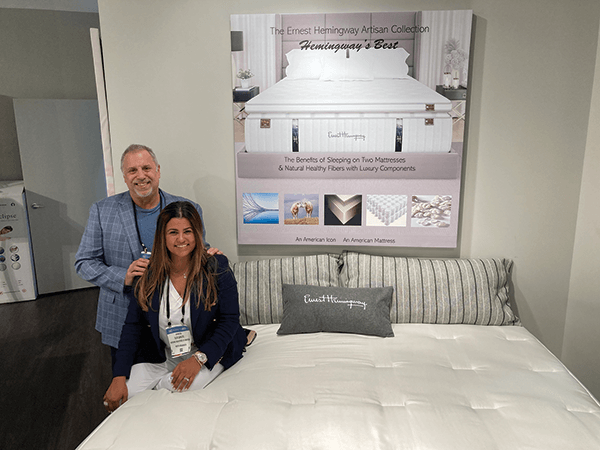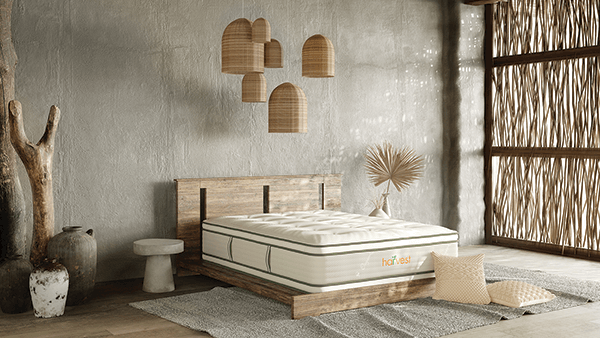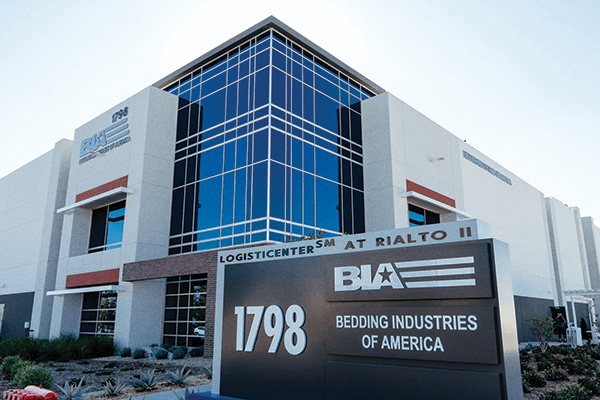Bedding Industries of America prepares for the future, building brands and focusing on sustainable products and consumer brand recognition.
Sustainability at the Beginning

executive assistant, Elis Carlitz, pose by an Ernest Hemingway mattress.
Long before consumers began asking for environmentally conscious products, Bedding Industries of America began planting the seeds of sustainability — while amassing a large portfolio of mattress brands.
About 15 years ago, BIA started its own recycling and sustainability program and began by outfitting the roof on its North Brunswick, New Jersey-based headquarters with
solar panels.
“Sustainability touches our manufacturing; it also touches the way we operate our businesses. So, it’s product and it’s operations,” says BIA CEO Stuart Carlitz. “We were really involved with sustainability long before it became a popular or hot topic.”
He says he was attracted to the subject because he likes the idea of bringing energy costs down and helping the environment by using less energy.
“We have recycling initiatives throughout the factories,” adds Steve Sciortino, BIA chief financial officer. “Most all our waste gets recycled, and we have various components that we recycle. The metal, the lumber, the foam scrap, it all gets recycled.”
What was even more compelling for Carlitz was learning about all the trash ending up in landfills and the toll it was taking on the environment. “We started planting trees a year ago with Evertreen,” he says. Evertreen is the only platform worldwide enabling users to plant real trees online and track them via satellite, according to its website.
Sustainable Products

Productwise, BIA achieved Greenguard Gold certification for its Natural Dreams mattresses. The company’s portfolio also includes the handcrafted, sustainable Millbrook line and its Harvest Green mattress program — all of which were driven by consumer demand.
“First, there was the chemically sensitive consumer who wanted an all-natural product for health reasons,” Carlitz says. “Then there were consumers who were so interested in recycling that it led us to develop products that would be appealing to them.”
Now the company is in the process of achieving Global Organic Textile Standard certification of products at all three factories in North Brunswick; Rialto, California; and Chicago.
Besides its eco-friendly collections, BIA boasts quite the portfolio: The company is one of the world’s largest mattress licensing and manufacturing groups, touting eight brands and seven patents within its vast network of manufacturing facilities around the globe.
At BIA West in Rialto, the 90,000-square-foot facility manufactures mattresses under the company’s Eclipse, Eastman House, Millbrook and Natural Dreams brands.

“BIA has grown to be among our industry’s leading manufacturers, and it has been exciting to see the massive impact we’ve had since expanding to the West Coast only 18 months ago,” says Jared Carlitz, chief operating officer for BIA. “The market is responding extremely well to our unique product line and differentiated value proposition.”
At BIA Midwest in Chicago, run by BIA Chief Revenue Officer Phil Carlitz, the company has increased production of existing collections, including Harvest Green, Eastman House, Eclipse, Ernest Hemingway, Natural Dreams and EmBrace Sleep, among others.
Focusing on Brand Recognition
Given all these brands, it’s no surprise that when it comes to future planning, Stuart Carlitz is focusing on brand recognition — specifically, consumer brand recognition — especially for BIA’s three major lines: Eclipse, Eastman House and Ernest Hemingway.
“I’d like to see more investment in the brand names so that the consumer recognition continues and grows,” Carlitz says. “We will be doing more consumer advertising, embracing the internet and getting our name in front of consumers more so they’re driving business into the stores.”
Another important area: private label. Carlitz says it’s important for retailers to focus on carrying private label or proprietary product. “Because of the internet dynamic, there’s a lot of cross-shopping,” he says. “So, for a dealer to have their own brand made by BIA, it adds a lot of legitimacy in product, so we have been doing a lot of private-label design.”
Sciortino foresees staying on the path toward expansion. “We have a lot of major initiatives in the hopper right now with major accounts, national accounts,” he says. “Seeing those through from beginning to end is always very gratifying. So, I would say there’s no endpoint on the horizon. As long as we’re all having fun and enjoying what we’re doing, we’ll just keep rockin’ and rollin’.”






